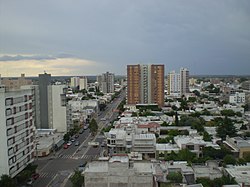Santa Rosa | |
|---|---|
 Panoramic of Santa Rosa | |
| Coordinates: 36°37′0″S 64°17′0″W / 36.61667°S 64.28333°W | |
| Country | |
| Province | |
| Department | Capital |
| Founded | 22 April 1892 |
| Government | |
| • Intendant | Luciano di Nápoli |
| Area | |
| • City | 1,500 km2 (600 sq mi) |
| Elevation | 175 m (574 ft) |
| Population (2010 census) | |
| • Urban | 102,880 |
| Time zone | UTC−3 (ART) |
| Postal code | L6300 |
| Phone code | +54 2954 |
| Website | (in Spanish) www.santarosa.gov.ar |
Santa Rosa (Spanish pronunciation: [ˈsanta ˈrosa]) is a city in the Argentine Pampas (lowlands), and the capital of La Pampa Province, Argentina. It lies on the east of the province, on the shore of the Don Tomás Lagoon, at the intersection of National Routes National Route 5 and National Route 35. The city (94,340) and its surroundings hold 102,610 inhabitants (2001 census [INDEC]),Census-ar 2.010 hold 124.101 inhabitants the capital y Toay around a third of the population of the province. Its current mayor is Luciano di Nápoli. Founded in 1892 by Tomás Mason, Santa Rosa did not develop into a relatively important agricultural centre until the second half of the 20th century. It is still one of the smallest provincial capitals of the country after Patagonian Rawson, Ushuaia and Viedma.
City sights include the Fitte neighbourhood (1930), the monument to San Martín, the Palace of Justice, the Teatro Español Theatre (1908), the Provincial Art Museum (with paintings by Raúl Soldi, Antonio Berni, Quinquela Martín and other important Argentine painters) and the Provincial Natural History Museum.
The Santa Rosa Airport (IATA: RSA, ICAO: SAZR) is located 2 kilometres from Santa Rosa on Route 35, and serves regular flights to Buenos Aires.
Near Santa Rosa is the city of Toay, together both cities form the Gran Santa Rosa metropolitan area.

